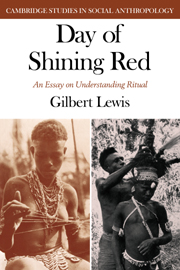Book contents
- Frontmatter
- Contents
- Analytical table of contents
- Preface
- 1 A question of interpretation
- 2 Problems of ritual in general
- 3 Views from one village
- 4 The rites of puberty seen
- 5 Rules of procedure and reflection on them
- 6 Silent forms but natural symbols?
- 7 Moon, river and other themes compared
- 8 For success in life
- 9 A choice of magic
- 10 Change and a rite falling into disuse
- 11 Inventory of themes
- References
- Index
- CAMBRIDGE STUDIES IN SOCIAL ANTHROPOLOGY
1 - A question of interpretation
Published online by Cambridge University Press: 30 October 2009
- Frontmatter
- Contents
- Analytical table of contents
- Preface
- 1 A question of interpretation
- 2 Problems of ritual in general
- 3 Views from one village
- 4 The rites of puberty seen
- 5 Rules of procedure and reflection on them
- 6 Silent forms but natural symbols?
- 7 Moon, river and other themes compared
- 8 For success in life
- 9 A choice of magic
- 10 Change and a rite falling into disuse
- 11 Inventory of themes
- References
- Index
- CAMBRIDGE STUDIES IN SOCIAL ANTHROPOLOGY
Summary
A sentence of Nadel is quoted from time to time to be criticised for the limit he set on interpretation: he wrote, ‘Uncomprehended symbols have no part in social inquiry, their social effectiveness lies in their capacity to indicate; and if they indicate nothing to the actors they are from our point of view, irrelevant, and indeed no longer symbols (whatever their significance for the psychologist or psychoanalyst)’ (1954, p. 108). Nadel can be understood to limit ‘symbol’ to those situations where the relationship between something and what it stands for is intended, conventional and can be put by the actor into words. It points up the distinction between the communication of meaning to people within the society (actors) and items of social behaviour or belief which express in an indirect or obscure fashion some principle, value, conflict or problem occurring in that society. Expression is not the same thing as communication. You can express your feelings to a stone, yet it is unmoved. You could also, like the mystic Henry Suso (Huizinga 1965, p. 148) eat three-quarters of an apple in the name of the Trinity and the remaining quarter in commemoration of ‘the love with which the heavenly Mother gave her tender child Jesus an apple to eat’ and unless you or Henry Suso told me, I would not, though I watched you twenty times, discern your symbolism or even that what you did was symbolical.
- Type
- Chapter
- Information
- Day of Shining Red , pp. 1 - 5Publisher: Cambridge University PressPrint publication year: 1980

